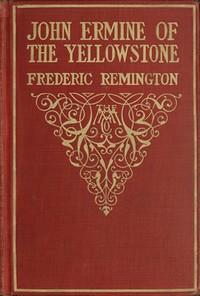Read this ebook for free! No credit card needed, absolutely nothing to pay.
Words: 19761 in 7 pages
This is an ebook sharing website. You can read the uploaded ebooks for free here. No credit cards needed, nothing to pay. If you want to own a digital copy of the ebook, or want to read offline with your favorite ebook-reader, then you can choose to buy and download the ebook.
e high lands into the St. Lawrence. The best description of this branch of the Kenebeck, is had from the Officers who passed this route under the command of General Arnold, in 1775.... The carrying place from boatable waters in it, to boatable waters in the river Chaudi?re, is only five miles over."
Among the most interesting maps of the Kennebec-Chaudi?re route may be mentioned Montresor's map of 1761, "A Draught of a route from Quebec to Fort Halifax," in the British Museum. The route is there given as up the "Yadatsou Chaudiere or Kettle River." When Wolf River was reached it was ascended; then to "River Ahoudaounkese." Here was a portage of five miles to within about that distance of Lake Oukeahoungauta; portage of about one half mile to Loon Lake; thence into Moosehead Lake at the head of the east branch of the Kennebec. A portage could be made into the Penobscot; and at the southeastern extremity of Moosehead Lake are the words "Portage to the Penobscot." The return route was up the Kennebec to "The Great Carrying Place to River of Tewyongyadight or the Dead River." This was Arnold's route, already referred to by Mr. Sullivan. Ascending the Dead to "The Amaguntic Carrying Place" the route is marked to "the River of Mekantique" and through "The meadow of Mekantique;" thence through "Lake of Me' Kantique de St Augustin" and into the Chaudi?re.
Perhaps the earliest map showing a road throughout the Kennebec and Chaudi?re valleys is "A New Map of Nova Scotia & Cape Britain" in the British Public Records Office. The road bears the name "Kenebec Road."
Among the Haldimand Papers in the British Museum is a most interesting "Journal from the last settlements on the Chaudiere to the first Inhabitants on Kennebec River kept by Hugh Finley, from the 13th of September that he left Quebec until the 30th that he arrived at Falmouth in Casco Bay in the Povince of the Massachusets Bay--1773." Finley had been appointed "Surveyor of Post roads on the Continent of North America" and, in view of the tedious length and the common retardments of the Lake Champlain route between Canada and New England, determined to explore the Chaudi?re-Kennebec route. Four Indian guides accompanied the surveyor, who were "to mark the Path by which a good road might be cut." The last farm on the Chaudi?re was "52 Miles S. Easterly of Quebec." "The reaches in this river are long between rapid and rapid, but navigable for batteaus only." On the fifteenth the party had reached "Rapide du Diable;" seven miles further was "La Famine" River where were two huts. Four miles further they arrived at "des loups" River. This was the common upward route of travel as the upper Chaudi?re route was interrupted by ponds, swamps, etc. Concerning Indian maps Mr. Finley makes an interesting statement: "It is impossible to guess distances from an Indian draft, that people have no idea of proportion."
On the eighteenth the party encamped early in the afternoon "on purpose to pack up our Provisions &c in proper Packages to be distributed in proportional burthens to each of the party as we were next day to proceed thro the woods." Then came a desperate journey of nine miles in nine hours up steeps, over and under trees which tore the canoes and almost exhausted their bearers. At the end of two small lakes a half mile portage brought the travelers to another lake. "Half over this carrying place is the just hight of Land between Canada & New England," wrote Mr. Finley, "consequently the boundary line between the Province of Quebec and Massachusets Bay will be a line drawn half way between the Lake we just left and this Lake."
According to Finley this portage was ninety-six miles from Quebec and forty-six from the last house on the Chaudi?re--by the route he had traversed. He proceeded down the Kennebec, up the "Androcogkin" to Brunswick and across by land to Casco Bay.
miles "It appears by this Journal, that the distance from Quebec to Launieres the last house on the River Chaudiere in a good road is 52
From Launier's house to carry a road in the best path through a country dry and level down to Noridgiwalk, the first and nearest settlement in New England 150
From Noridgewalk to Oaks's or Wassarunset R 10
It is clear that the route from Quebec to the Kennebec was by way of "des loups" River to Moosehead Lake--named, writes Finley, "from a very remarkable Mountain the S side about nine miles down. the Indians say that it resembles a moose deer stooping." It is equally clear that the route from the Kennebec to Quebec was by way of the western branch, the Dead River and the Chaudi?re.
This route was made historic by Arnold's famous campaign of 1775 and has recently been described with intense feeling by Professor Justin H. Smith.
"Arnold's men found lower Dead River, as we can see from their journals, much as it now is. On both sides luxuriant grass covered the plain, or faded out in the reaches of poorer soil; tall evergreens, rather thinly planted, soughed and swayed above it; while here and there a glimpse could be had of goodly mountains, the confines of the valley." Professor Smith graphically describes the trials of those who traveled by water. Those who attempted to travel the "Kenebec Road" suffered even worse: "The land parties fared no better. It was impossible to keep along the river. Detours and wide circuits multiplied all distances. Swollen rivulets had to be followed up until a narrow place was found and a tree could be felled across for a bridge. Once, if not more than once, a party marched for miles up a stream only to discover that it was not Dead River at all. At night many of the men were unable to find the boats and had to bivouac as they could, without supper and without breakfast." At last the brave band neared the portage to the north-flowing waters. Despite their distressing fatigues "there was only one thought:" writes Professor Smith, "advance; and the army set forward as rapidly as possible on the twenty-fifth and longest portage, four miles and a quarter over the Height of Land. For once their misfortunes wore the look of blessings: there was little freight. The provisions weighed only four or five pounds per man. A large part of the gunpowder proved to be damaged, and was thrown away.... The bateaux had broken up one by one, until some of the companies had scarcely any left. Morgan had preserved seven, and was determined on taking them across, for there was no other way to transport his military stores down the Chaudi?re; but resolution of such a temper was now beyond mere men. An attempt was made to trail the bateaux up a brook that enters Arnold Pond; but the attempt had to be given up, and each company, except Morgan's, took only a single boat over the portage.
Free books android app tbrJar TBR JAR Read Free books online gutenberg
More posts by @FreeBooks


: John Ermine of the Yellowstone by Remington Frederic - Western stories; Indian captivities Fiction; Crow Indians Fiction; Yellowstone River Valley Fiction








